Mexico City Neighbourhoods, Locations and Districts
(Mexico City, Federal District, Mexico)
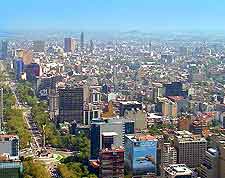
The enormous and exciting city that is Mexico City is divided into interesting districts, historic neighbourhoods, hotel zones and residential areas. The Historic Centre (Centro Historico) of Mexico City is a great place to begin getting acquainted with the sprawling city and is based around the enormous Plaza de la Constitución, otherwise known as El Zócalo.
Other parts of today's Mexico City were once surrounding towns and villages. Swallowed up by this spreading metropolis, these locations are considered to be suburbs and outlying districts, such as San Angel. Other notable locations and neighbourhoods within Mexico City include the La Condesa and Roma districts, the Polanco district, Alameda Central and the Zona Rosa.
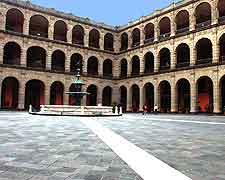
Centro Historico District
Having recently undergone much renovation work (at a cost of more than $50 million), Mexico City's Centro Historico is filled with a host of sightseeing opportunities, with everything from Aztec remains to grand palaces from the 16th century, such as the ancient Main Temple (Templo Mayor) and also the Palacio Nacional, where the actual offices of the president and Mexican congress are based. Now classed as a UNESCO World Heritage Site, Mexico City's Centro Historico district is a major draw card and not to be missed.
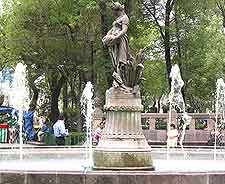
Alameda Central District
Alameda Park, often referred to as the Central Park, is the only sizable park in central Mexico City and therefore an extremely important green space. The park itself is surrounded by a number of particularly interesting museums and structures and is around 1 km / 0.5 miles from the Zócalo. Sandwiched between the Hidalogo and Bellas Artes metro stations, the Alameda is generally at its busiest on Sundays, when outdoor concerts often take place. At the eastern end, the Palace of Fine Artes (Palacio de Bellas Artes) dominates the area with its white marble exterior.
Plaza de la República District
The Plaza de la República is situated on the western side of the Alameda Central district and is best known for being home to the Art Deco-style, domed Monumento a la Revolución, which remembers the events of the Mexican Revolution. Located on the north-eastern side of Mexico City's Plaza de la República, the Frontón de México is another significant Art Deco structure, while for art lovers, pay a visit to the San Carlos Museum (Museo Nacional de San Carlos), on the Puente de Alvarado.
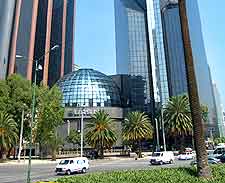
Paseo de la Reforma District
One of the city's most prominent boulevards, the Paseo de la Reforma heads in a south-westerly direction and dissects much of Mexico City, passing the Alameda Central district and also through the Chapultepec Forest (Bosque de Chapultepec). This is an extremely historic paved road and was originally built to link the castle at the top of the Chapultepec Hill. Planting and gardens line much of the boulevard, which connects a number of large traffic islands (glorietas), where sculptures, monuments and statues are often centrepieces, such as the Monumento Cristóbal Colón and the Monumento a Cuauhtémoc.
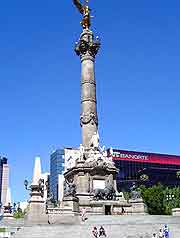
Polanco District
Located on the northerly side of the Bosque de Chapultepec, the Polanco district is an upmarket location, comprising a large residential neighbourhood, numerous shops, boutiques and restaurants, and plenty of interest for tourists. The Angel of Independence (Monumento a la Independencia / El Ángel) is an important landmark here and located along the Paseo de la Reforma.
Zona Rosa District
The Pink Zone of Mexico City goes by the name 'Zona Rosa' and is integral to local city life. This is a diverse part of the city, where the main gay community resides, along with a significant number of Korean residents. Many coffee shops grace the sidewalks, with one of the main attractions being the Mexico City Wax Museum (Museo de Cera de la Ciudad de México) on Londres, a good place to enjoy life-size waxwork models of famous people. The fun Ripley's Believe It or Not Museum (Museo Ripley's) is also nearby and combined tickets for both museums are available and offer good value.
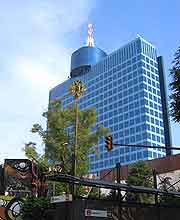
San Angel District
Just before the mid-20th century, San Angel was a small village outside Mexico City and sited next to large open expanses of fields and woodlands. San Angel is now very much a part of Mexico City and considered to be a district, with an appealing mixture of period and modern buildings. The main thoroughfares are the Avenida Revolución and the Avenida Insurgentes Sur, around which a number of quality attractions can be found, such as the World Trade Centre. Further highlights include the imposing Monumento al General Alvaro Obregón, sculptures by French artist Rodin at the Museo Soumaya, and the Plaza San Jacinto, where a bustling market takes place each Saturday.
La Condesa and Roma Districts
This area of Mexico City offers a distinctive Colonial elegance, with a series of small parks and streets lined with mature palm trees. This has long been a particularly trendy spot to be seen and features many pedestrianised areas, where you are able to stroll around the buildings and cafes, appreciating the Art Deco facades. The Parque México provides the perfect respite, while nearby and to the north-west, the Parque Espana is extremely family orientated and boasts a funfair aimed at children.
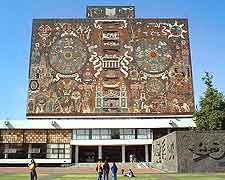
Ciudad Universitaria District
The University City (Ciudad Universitaria district) lies approximately 2 km / 1.5 miles directly south from Mexico City's San Angel neighbourhood. Here you will find the campus of Mexico's biggest and most important university, the highly acclaimed Universidad Nacional Autónoma de México (UNAM). Founded in the middle of the 16th century, this historical university also boasts stylish modern architecture and has around 300,000 teachers and students. Over the years, a number of political demonstrations have taken place at the university. Look out for regular shows within the theatres at the Centro Cultural Universitario (CUC), landscaped botanical gardens and the impressive science museum (Museo Universitario de Ciencias).
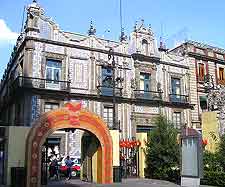
Coyoacán District
One of the most attractive and pleasant parts of Mexico City, the Coyoacán district lies off the Avenida Miguel Angel de Quevedo, some 10 km / 6 miles south of the city centre.
Full of Colonial character and narrow cobbled streets, Coyoacán is home to a series of plazas, public parks, cafes, churches and cultural attractions, such as the Centennial Gardens (Jardin Centenario), Leon Trotsky Museum (Museo León Trotsky), and Cortez Palace (Palacio de Cortés).
 The enormous and exciting city that is Mexico City is divided into interesting districts, historic neighbourhoods, hotel zones and residential areas. The Historic Centre (Centro Historico) of Mexico City is a great place to begin getting acquainted with the sprawling city and is based around the enormous Plaza de la Constitución, otherwise known as El Zócalo.
The enormous and exciting city that is Mexico City is divided into interesting districts, historic neighbourhoods, hotel zones and residential areas. The Historic Centre (Centro Historico) of Mexico City is a great place to begin getting acquainted with the sprawling city and is based around the enormous Plaza de la Constitución, otherwise known as El Zócalo.





